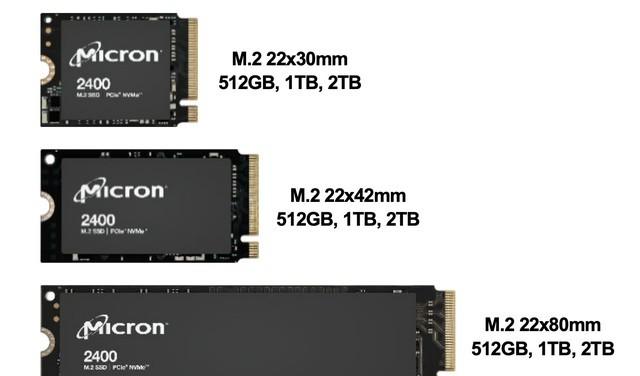On January 25, Beijing time, Micron Technology, a supplier of memory and storage solutions, announced that it has shipped the world's first 176-layer QLC (four-layer unit) NAND SSD in bulk. Micron's 176-layer QLC NAND uses an advanced NAND architecture with leading storage density and optimized performance for a wide range of data-intensive applications. Designed for cross-client and data center use cases, the new NAND technology has been introduced with micron 2400 SSDs, the world's first PCIe 4.0 client SSD based on 176-layer QLC. The technology will also be used in some of Micron's Consumer SSDs for system designers as components.

Micron Client PCIe 4.0 SSD 2400 Series
Micron has previously pioneered the industry's first 176-layer TLC (three-layer unit) NAND, and the 176-layer QLC NAND released this time has set new highs in terms of stacking layer count and density. In addition, Micron's 176-layer QLC NAND has 33% faster input/output (I/O) speed and 24% lower read latency[2] compared to the previous generation solution; the replacement gate architecture is the only production QLC flash memory that combines charge capture with an off-array CMOS (CuA) design. These upgrades will drive the adoption of QLC SSDs in the client PC market – QLC adoption in the client PC market is expected to triple to more than 35% by 2023, with a capacity (bit) share of nearly 80% in 2025. [3]
Jeremy Werner, Corporate Vice President and General Manager of Micron Technologies' Storage Division, said, "The 2400 Series SSDs will drive the transition to QLC storage in the client market with industry-leading Micron 176-layer NAND technology. The new PCIe 4.0 SSD series further strengthens Micron's market leadership and will significantly accelerate the adoption of QLC in client devices, providing a wider range of cost-effective storage options for system designs. ”
QLC NAND SSD for routine calculations
The Micron 2400 brings higher storage capacity to mainstream and cost-effective NVMe SSDs, providing original equipment manufacturers (OEMs) with a more flexible design solution for a superior user experience. Combining 176-layer NANDs with PCIe 4.0 technology, the 2400 Series SSDs double the performance of Micron's previous-generation client SSDs, reducing boot and load read times by 23%. [4]
The Micron 2400 SSD is also the only SSD in the world to offer a 2TB capacity M.2 2230 specification. Compared to the M.2 2280 specification, the 2230 format saves 63% of physical space, increases design flexibility, and is more suitable for small portable notebooks. The 2400 SSD is also available in M.2 2242 and 2280 specifications and is equipped with universal firmware, minimizing design qualification.
The 2400 Series SSDs provide a stable user experience for different applications, thanks in large part to Micron's Host Memory Buffering (HBM) technology, which gives hosts the flexibility to optimize performance. Its low-power performance is sufficient to support 24/7, unrestricted computing, and its active idle power consumption is reduced by 50% compared to Micron's previous-generation solution. Micron's 2400 Series SSDs meet intel Project Athena specifications, and laptops can actually last more than 9 hours even with HD display turned on. [5]
[1] ONFI 4.x——1600 MT/s与1200MT/s
[2] Data comparison based on Micron's previous generation of 96-layer QLC NAND
3. Source: Forward Insights, SSD Insights, November 2021
[4] Data comparison based on Micron's previous generation 96-layer QLC NAND
[5] Data based on Intel Tests released Intel.com: The Athena Program, Intel's innovative strategy for high-end notebooks
(7858328)